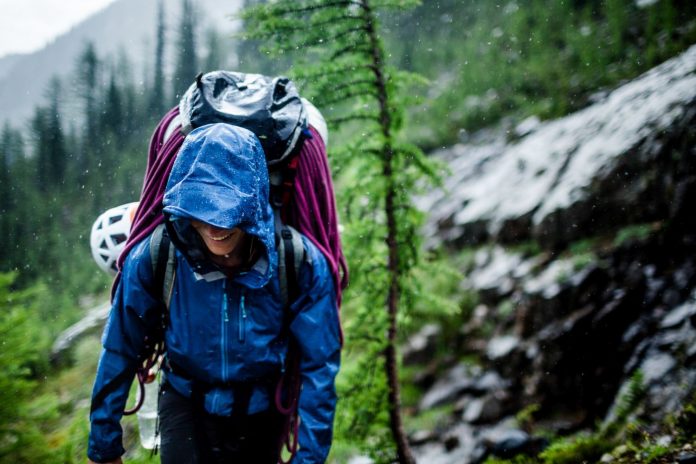It’s a rainy Sunday morning … so I went for a hike. Why? Well honestly, walking in the rain can be its own excuse, it’s got a peaceful groove all its own. I also put on my ‘bugout gear’, what I’d expect to wear if I had a choice and had to grab the bag and GO, so I could test its suitability in the rain. Disasters do not guarantee that they’ll wait for a sunny day, after all. Here are some of the things I thought about as I walked:
Rain’s not so bad if your feet are dry
Dry feet is always a comfort issue. It can be important for blister protection too. I’ve walked fifteen miles after wetting my feet on the first creek crossing off a day and come back blister-free, so it depends on the shoes, socks, and walker. No doubt though, blisters are more common in wet shoes. (Here are some other things I learned about blisters on that trip.)
The hard part is, is it worth getting totally waterproof boots? My hiking companion Doc favors them, but she hikes mostly in desert areas where the streams are less than boot high. I don’t, as being in the Midwest means that if you’re off-trail crossing streams, it’s going to get higher than your boot tops anyway. Waterproof boots are heavier, hotter, and more expensive than breathable models.
My sweet spot is breathable boots with plenty of waterproofing (such as Scotchgard). That keeps my feet dry in a long rain walk (if the rain’s not pounding) and when walking through wet grass. If I have to cross a creek, it takes them off or walks in them wet. When buying boots, pay attention to if they are waterproof for the first inch or two of their height. That much waterproof is common and helpful.
Related: How to Build a First Aid Kit – Prepper Edition
Packs with rain covers are a good thing
The rain covers are worth the weight and work well … until you have to get into the pack, of course. Straps and belt can be Scotchgarded. Bonus tip: while it looks goofy as all get out, you can stretch the rain cover over your head to keep from being battered too much by a sudden hailstorm. If, you know, that sort of thing would ever happen. Which it wouldn’t, of course.


Ok, *maybe* a sudden hailstorm might come up where you’d like to use that rain cover creatively.
Choices to keep the body dry
If there’s a better answer than a lightweight, somewhat over-sized, long-tailed rain jacket, I haven’t found it. Make sure it’s breathable because wet from sweat is still wet. The long tail is to keep your butt dry – especially since the pack cover tends to runoff there if not discouraged. A hood is great if you’re not going to be wearing a hat with an all-around brim, otherwise, cold water runs down your neck to your back. Bleh.
I have a ‘size too big’ good raincoat I keep in my BOB. The large size both lets me pack warmer layers under it in cold weather and have enough sleeve to pull down over my hands when walking. That makes a big difference in cold weather.
Plastic ponchos have the advantages of being cheap, light, taking little room, and being reasonably effective. They flap around way too much though, and you end up having to choose between limiting your movement and staying dry. They’re a good compromise when space is at a premium.


The poncho kept me dry in the body even here, but I sure had to hang on to it.
Umbrellas are fine for walking around town for rain without much wind but are way too cumbersome for longer use.
Just getting wet – deal with it, buttercup, it’s an emergency! – is an ok solution in warm weather, but becomes a real risk in the cold.
Related: 12 Things You Forgot to Add to Your Stockpile
Hats that repel rain are your friend
A wet head is very chilling. It also runs down your neck and wets the rest of you. If you wear glasses, as I do, rain also degrades your vision a lot. I have a waterproof ball-cap style cap that fits under my jacket hood that works very well. Brimmed waterproof hats are good too but take up more space in the pack than I like.
Inside the pack
The rainwater will get in that pack sooner or later. You have to stop and get something out, or it wicks in from when you set the pack down (a pack with a waterproof bottom reduces that), or you have to get stuff out of your pack and set it aside for the moment to dig deeper … life happens.
Reduce the impact by putting water-sensitive things in their own plastic bags. Bonus: Keeping the spare clothes in ziplock also keeps them rolled up tight and causing minimum chaos in the bag.
Don’t let the rain ruin your bugout!





















